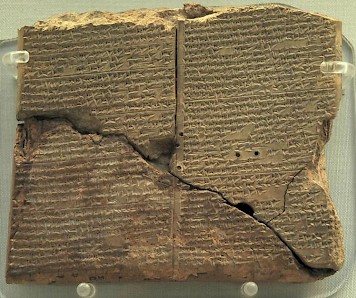ABC 21 (Synchronic Chronicle)
The Synchronic Chronicle (ABC 21) is a historiographical text from ancient Babylonia. It deals with the relations between Assyria and its southern neighbor Babylonia (which is called Karduniaš), and is an important source for those who want to study the chronology of this period, as it offers many synchronisms. The tablet was written in c. 800 BCE.

For a very brief introduction to the literary genre of chronicles, go here. The translation on this webpage was adapted from A.K. Grayson, Assyrian and Babylonian Chronicles (1975) and Jean-Jacques Glassner, Mesopotamian Chronicles (Atlanta, 2004)
The text, which informs us about a number of boundary conflicts and has a strong pro-Assyrian bias, is preserved on three tablets from the library of king Aššurbanipal in Nineveh. Tablet A is the main text, which can (at the edge) be supplemented with tablets B and C. The chronicle purports to render the text of a boundary stone between Assyria and Babylonia that stood somewhere on the east bank of the Tigris. This may be a literary fiction. The Babylonian version is Chronicle P.
The text must have been composed after the accession of Adad-nirari III in 810, but not much later, because there are no references to later troubles.
This is the first part of this web page. The second part is here.
Column I
[i.B1] ... for the god Aššur
[i.B2] ... his utterance
[i.B3] ... settlements
[i.B4] ... Meli-Šipak[?]
[i.B5] ... forever
[i.B6] ... he makes known the word
[i.B7] ... praise of strength
[i.B8] ... when he ruled all
[i.B9] ... former kings
[i.B10] ... they were seized
[i.B11] ... fall
[lacuna]
[i.A1'] Karaindaš, king of Karduniaš note
[i.A2'] and Aššur-bêl-nišešu, king of Assyria,
[i.A3'] made a treaty[2] between them
[i.A4'] and took an oath together concerning this very boundary.
[i.A5'] Puzur-aššur, king of Assyria, and Burnaburiaš,
[i.A6'] king of Karduniaš, took an oath and
[i.A7'] fixed this very boundary-line.
[i.A8'] In the time of Aššur-uballit,note king of Assyria, Kassite troops[10]
[i.A11'] rebelled against and killed Karahardaš,[8]
[i.A9'] king of Karduniaš, son of Muballit-šerua,
[i.A10'] the daughter of Aššur-uballit.
[i.A12'] They appointed Nazibugaš,[11] a Kassite, son of a nobody, as sovereign over them.
[i.A13'] To avenge Karaindaš, his grandson,[14] Aššur-uballit
[i.A14'] marched to Karduniaš.
[i.A15'] He killed Nazibugaš, king of Karduniaš.
[i.A16'] Kurigalzu the Younger, son of Burnaburiaš,
[i.A17'] he appointed as king and put him on his father's throne.note
[i.A18'] In the time of Enlil-nirari,note king of Assyria, Kurigalzu the Younger, was king of Karduniaš.
[i.A19'] At Sugagi, which is on the Tigris, Enlil-nirari, king of Assyria,
[i.A20'] fought with Kurigalzu. He brought about his total defeat, slaughtered his troops and
[i.A21'] carried off his camp. They divided the districts[22] from Šasili of Subartu,
[i.A22'] to Karduniaš into two and
[i.A23'] fixed the boundary-line.
[i.C24'] Adad-nirari, king of Assyria, and Nazi-Marrutaš, king of Karduniaš,note
[i.C25'] fought with one another at Kar-Ištar of Ugarsallu.
[i.C26'] Adad-nirari brought about the total defeat of Nazi-Marrutaš and
[i.C27'] conquered him. He took away from him his camp and his standards.
[i.C28'] As for this very boundary-line, they fixed a division of[31]
[i.C29'] their confines from Pilasqu,
[i.C30'] which is on the other side of the Tigris, and Arman of Ugarsallu
[i.C31'] as far as Lullume.
Column II
[ii.C1] [lacuna]
[Tukulti-Ninurta, king of Assyria, and] Kaštiliašu, king of Karduniašnote
[ii.C2] ... in open battle.
[lacuna]
[ii.B1'] his servants, he made ...
[ii.B2'] to Mount Kullar [...]
[ii.B3'] Enlil-kudurri-usur, king of Assyria, and Adad-šuma-usur, king of Karduniaš,note with another
[ii.B4'] did battle. As Enlil-kudurri-usur and Adad-šuma-usur
[ii.B5'] were engaged in battle, Ninurta-apil-ekur
[ii.B6'] went home. He mustered his numerous troops and
[ii.B7'] marched to conquer Libbi-ali (the city of Aššur).
[ii.B8'] But [...] arrived unexpectedly, so he turned and went home.
[ii.B9'] In the time of Zababa-šuma-iddina, king of Karduniaš,
[ii.B10'] Aššur-dan, king of Assyria, went down to Karduniaš.note
[ii.B11'] Zaban, Irriya, Ugarsallu and [...]
[ii.B12'] he captured. He took their vast booty to Assyria.
[ii.A1'] [lacuna]
together they made an entente cordiale.
[ii.A2'] he went home.note
After he had gone, Nebuchadnezzarnote
[ii.A3'] took his siege engines and Zanqi, a fortress in Assyria,
[ii.A4'] he went to conquer. Aššur-reš-iši, king of Assyria,
[ii.A5'] mustered his chariots to go against him.
[ii.A6'] To prevent the siege engines being taken from him, Nebuchadnezzar burnt them.
[ii.A7'] He turned and went home.
[ii.A8'] This same Nebuchadnezzar with chariots and infantry,
[ii.A9'] went to conquer Idi, a fortress[8] of Assyria. Assur-reš-iši
[ii.A10'] sent chariots and infantry to help the fortress.
[ii.A11'] He fought with Nebuchadnezzar, brought about his total defeat, slaughtered his troops and
[ii.A12'] carried off his camp. Forty of his chariots with harness were taken away and
[ii.A13'] Karaštu[?], Nebuchadnezzar's field-marshal, was captured.
[ii.A14'] Tiglath-pileser I, king of Assyria, and Marduk-nadin-ahhe, king of Karduniaš.note
[ii.A15'] Twice Tiglath-pileser drew up[16] a battle array of chariots, as many as were by the Lower Zab,
[ii.A16'] opposite Ahizûhina, and
[ii.A17'] in the second year he defeated Marduk-nadin-ahhe at Gurmarritu, which is upstream from Akkad.
[ii.A18'] Dur-Kurigalzu, Sippar-ša-Šamaš
[ii.A19'] Sippar-ša-Anunitu,
[ii.A20'] Babylon, and Upû, the great urban centers,
[ii.A21'] he captured together with their forts.
[ii.A22'] At that time, Ugarsallu
[ii.A23'] he plundered as far as Lubda.
[ii.A24'] He ruled every part of Suhu as far as Rapiqu.
[ii.A25'] In the time of Aššur-bêl-kala, king of Assyria,note
[ii.A26'] Marduk-šapik-zeri was the king of Karduniaš.
[ii.A27'] An entente cordiale
[ii.A28'] they together made.
[ii.A29'] At the time of Aššur-bêl-kala, king of Assyria,
[ii.A30'] Marduk-šapik-zeri, king of Karduniaš, passed away.
[ii.A31'] Aššur-bêl-kala appointed Adad-apla-iddina, son of Esagil-šaduni, son of a nobody,
[ii.A32'] as sovereign over the Babylonians.
[ii.A33'] Aššur-bêl-kala, king of Assyria,
[ii.A34'] married the daughter of Adad-apla-iddina, king of Karduniaš, and
[ii.A35'] took her with a vast dowry to Assyria.
[ii.A36'] The peoples of Assyria and Karduniaš
[ii.A37'] were joined together.